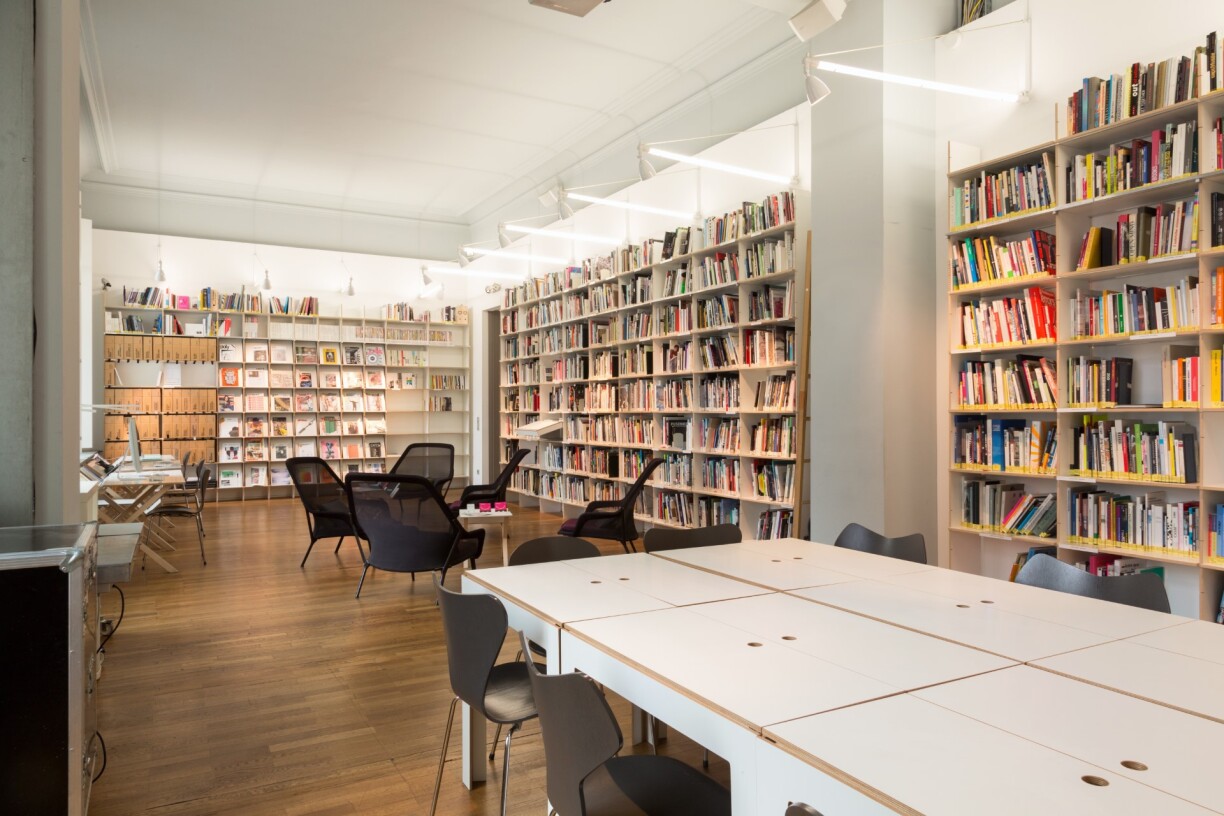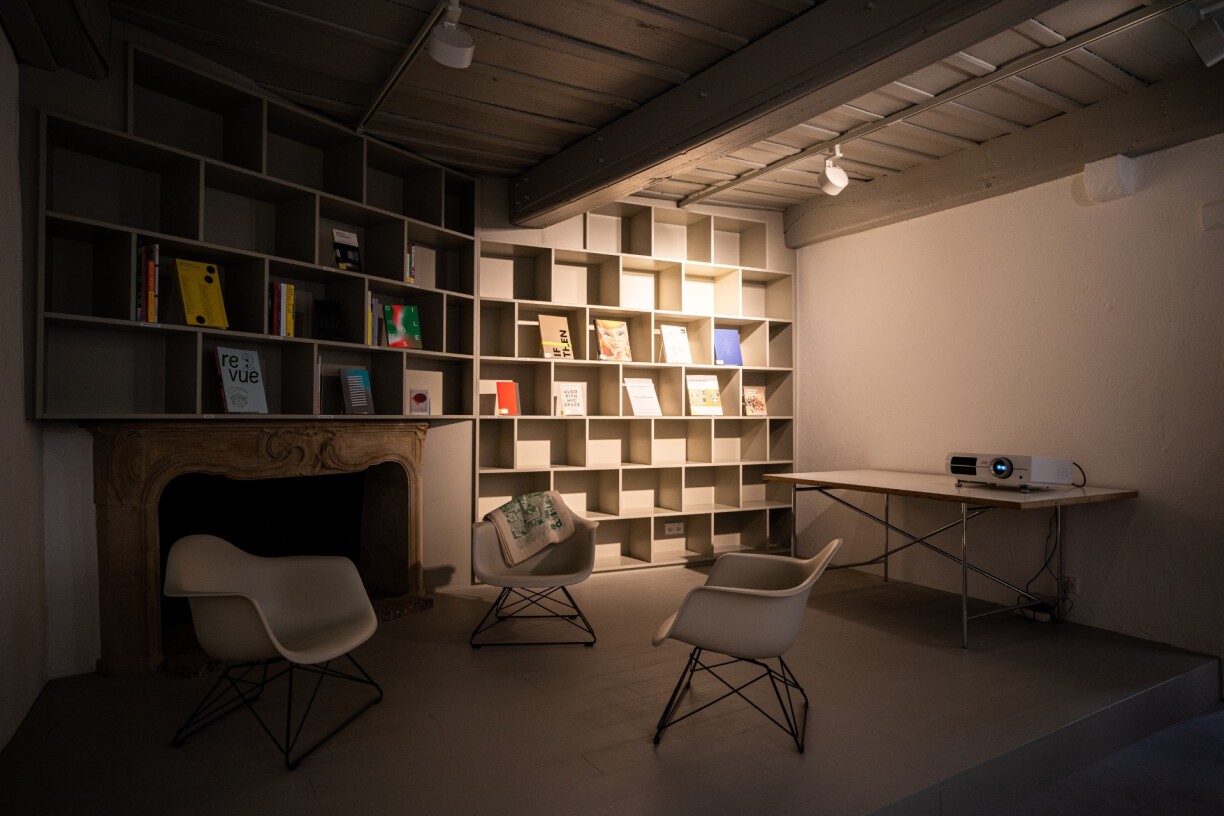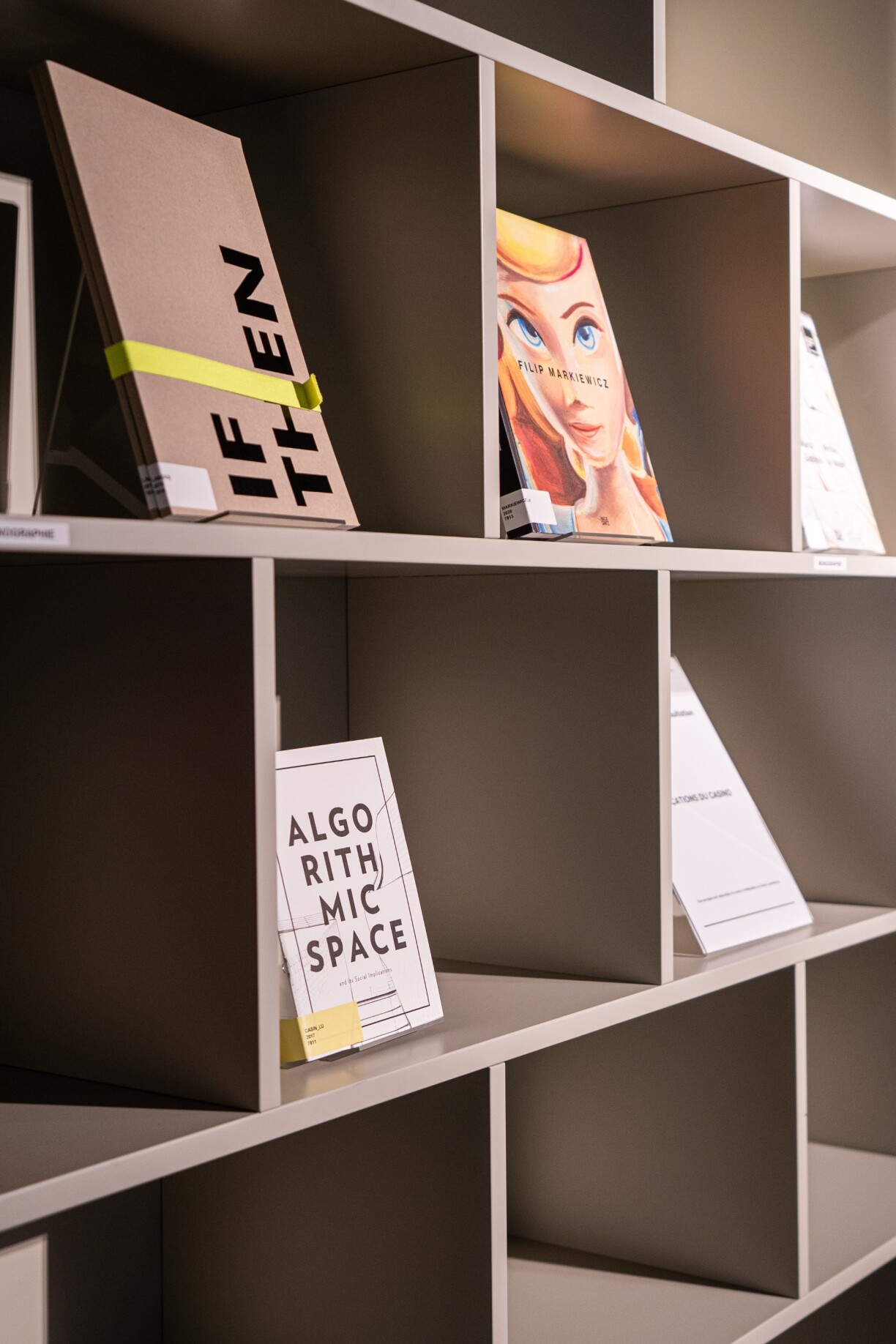
It is an experimental space for creative activities and conversation in both the main gallery and the studio for upcoming artists, the latter known as the Casino Display. There is also a bookshop, a cafe, and the main library called InfoLab, which specialises in contemporary art. I would like to focus on the small library of books inside the Casino Display and the InfoLab, the larger library of the two. Virginie Dellenbach is responsible for looking after both spaces and has the desirable power of selecting which books and artistic magazines are shown in those spaces. She also works together with the exhibition artists, looking at which books they referred to, and putting them on display, so people can understand how the artists work, thus creating another relationship with the public.
The Casino Display is primarily an artistic studio – it provides a vital space for young resident artists to collaborate, produce work and hold exhibitions. Due to the absence of a dedicated art school in Luxembourg, the Casino Display is truly an essential platform for fresh creatives to not only develop their practice but to help connect them with other art schools. There is a selection of books in this cosy space, hence a small library. The space holds publications both from the Casino and the surrounding art schools in the greater region, plus literature the artists used as a reference and inspiration.
Meanwhile, the Infolab in the main building of the Casino Gallery, is an ideal place for open conversations between people from all areas of life, both creative and academic. There are also artistic magazines and journals in different languages, including your beloved ROUX magazine, which we are very grateful to them for displaying. A multilingual book club has also been running since October 2023, open to everyone. Virginie has recommended two of her favourite titles, kindly explaining why in her own words:

Devet, Annelys et al. Subjective Atlas of Luxembourg.
Sint Pieters Leeuw: Subjective editions, 2019 (Book’s language: English)
“The Subjective Atlas of Luxembourg is part of the editorial project series “Subjective Atlas” initiated by Annelys Devet. These atlases explore specific places or themes, through personal and subjective perspectives.
In Luxembourg, this collaborative project brought together over 100 creative minds at Casino Luxembourg, all contributing to map their country through maps, infographics, photos, texts or drawings. Each participant brought their interpretation, experience, or personal vision of Luxembourg. Thus, this atlas doesn’t guide the reader to find their way, but from these multiple viewpoints, it offers a poetic and pluralistic vision of Luxembourg.
I enjoy recommending this book to people who are not familiar with or know little about Luxembourg because many people have a very negative image of the country. I greatly appreciated discovering each piece of history developed in this collaborative project.”
Verna Jean-Luc et al. Jean-Luc Verna: “Vous n’êtes pas un peu beaucoup maquillé? - Non”.
Vitry sur Seine: MAC VAL, 2016 (Book’s language: French)
“This book is a monograph about the French artist Jean-Luc Verna, published on the occasion of his exhibition at the Mac-Val, in Vitry-sur-Seine, in 2016. Verna is known for his work in performance art, photography and drawing. He uses his own body as an artistic medium. His work explores themes such as sexuality, gender, religion and the subversion of social norms. His work is often characterised by a provocative, raw, dark aesthetic and a deep reflection on existential and social issues. His work also shows how art provides an opportunity for artists to express their traumas. As for the artist Verna, he is an artist who fascinates me because he is complete. He is touching, and provocative, but also he shows his vulnerabilities. And I believe that art has that power to allow us to feel multiple emotions.”

Meanwhile, my recommended books available at the InfoLab are summarised below, including discussions on artistic practices, theory and aspects of art history:
Nicolas Bourriaud. Relational Aesthetics.
Dijon: Les Presses Du Reel edition, 1998 (Book’s language: French, with the English translation version published in 2002)
This essay on the art term “relational aesthetics” was coined by the French curator and art critic Nicolas Bourriaud. He argues that art should be judged on its ability to stimulate social interaction and dialogue, rather than its meaning or content. Performative art, street interviews, and interactive sculptures are among the types of artwork available that fall under this category. Besides being an important book on art, it has a personal significance to me, as it was my first encounter with art theory (alongside Rosalind Krauss): I am forever grateful to a former tutor Dr Christian Edwardes, who introduced me to not only art theory but also aesthetics.
Sophie Calle.Did You See Me?
Munich: Prestel, 2004 (Book’s language: English)
When I first encountered French artist Sophie Calle’s book Did You See Me? whilst studying at Central Saint Martins, I was in awe of her conceptual art practice, and this particular title is a retrospective of Calle’s exploration. She is acting as not only an artist, but also a documentarian, photographer, and flâneuse, chronicling intimate moments in strangers’ lives. Photographs, diary pages, and film stills are included in the book, and they are a pleasure to look through. In particular, I appreciate her photographs and film stills because they embody an essence that cannot be captured by any other medium, let alone photography. Despite the controversial nature of the subject matter she interacts with, it contains a flair which, as mentioned, is hard to come by, especially with the extreme availability of modern technology today, making us nostalgic for the days when technology was simpler.
Midori Matsui.The Age of Micropop: The New Generation of Japanese Artists.
Tokyo: Parco co, ltd and Isamu Ito, 2007 (Book’s language: Japanese and English)
Micropop is an attitude of late post-modernism that reorganises fragments of many communication processes without regard to a major philosophy, ideology or aesthetic. As well as pointing to marginalised subjects within a dominant culture, the term was influenced by French philosophers Felix Guattari and Gilles Deleuze, and French anthropologist Michel de Certeau’s thoughts on everyday life. In other words, it means focusing on little moments of daily life, which is part of the Japanese culture as a whole.
The book covers 15 renowned Japanese artists including Yoshimoto Nara, Aya Takano and Chihiro Mori. Admittedly, there is a unique style to this book that is common in Japan, creating a mystical feel for non-Japanese readers. However, its gentleness goes a long way towards understanding Japanese art, and what we may need for ourselves.
To sum up, the Casino, the InfoLab and the Casino Display are hidden gems worth visiting to take a pause. And not only when a change of pace is needed from student life, but when the urge to discover art’s past, present and future hits you, which I humbly hope this recent discovery inspires you to do.
Roux Magazine is made by students at the University of Luxembourg. We love their work, so we decided to team up with them and bring some of their articles to our audience as well. You can find all of their issues on Issuu.